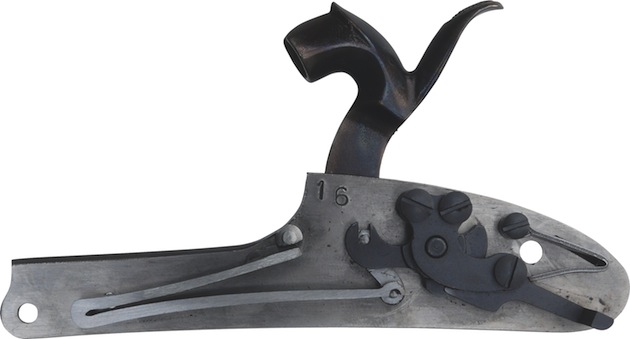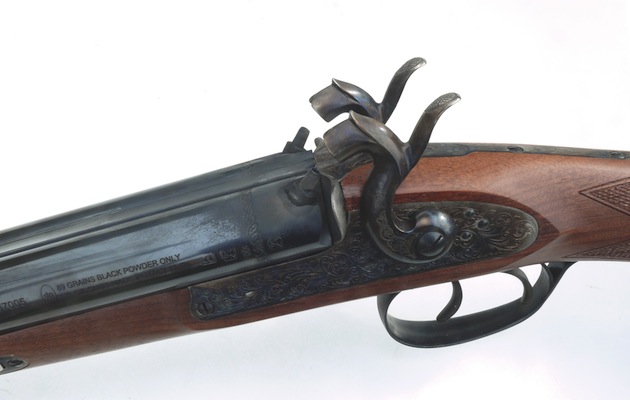Win CENS ProFlex DX5 earplugs worth £1,149 – enter here
Pedersoli Classic 12-bore muzzle-loader

Interest in the revival of muzzle-loading took off in the early 1970s, extending beyond the clay shoot to use in the field. The owner of one quite large shoot that I knew insisted that at the latter end of the season only muzzle-loaders were used. Though interest has declined a little, Shooting Times still reports on shoots where both vintage breechloaders and muzzle-loaders are put to the use for which they were intended.
The problem now for an interested shooter can be finding a sound, original gun. The days when you could get a usable double for £25 are long gone and many increasingly valuable guns seem to have finished up in the hands of collectors. There is, of course, another option, such as this modern-made Pedersoli Classic on test.
Sound advice
It was a novelty to receive a muzzle-loader complete with an instruction book. When I started tinkering with front-stuffers we found our own way and relied on advice from others, which was not always the right advice.
Like a lot of men, I am a bit reluctant to read instructions but I can highly recommend this booklet, especially to the beginner or novice. Chapters on precautions concerning the use of blackpowder, cleaning instructions and loading and shooting a side-by-side are included, along with other sound, common-sense advice.
First impressions were of slight surprise, but one has to remember this Pedersoli is, after all, a modern gun, albeit built on 19th century principles. It has glossy black barrels contrasting with immaculate colour case-hardened locks and hammers and a chequering pattern on the stock that, at least to British eyes, owes more perhaps to styling than tradition.
Looking at the detail, though, it runs true to form, incorporating the sort of features you would expect on a muzzle-loading double shotgun. The barrels are narrow across the breeches, the hammers tall and proud, while the cross-bolted fore-end is just what you’d expect. The hand of the stock is fairly substantial, the butt quite chunky and, along with the steel heelplate, they are all very much copies of original features. Even a fore-end free of chequering can be found on 19th century guns.
When I first handled the Classic, it felt a little heavier than the 7lb 3oz recorded on my scales. This is mainly because the balance is biased forward. The advantage of that is the smoothness of swing that inspires confidence. A 14½in length of pull is adequate for many users and the drop across the stock of 1¼in to 2½in is similar to many modern breechloaders.
Hands on
One of the first things you learn with muzzle-loaders is the advantage of being able quickly to detach the barrels for cleaning, involving solvents and hot water accompanied by a curiously distinctive smell reminiscent of rotten eggs. The barrels of this Pedersoli come off in the time-honoured manner of putting the hammers on half cock, pushing the fore-end bolt to one side and lifting the barrels at an angle to free the hooked breech.
There is certainly more hands-on involvement with a muzzle-loader, which is undoubtedly one of the attractions for enthusiasts. It can even be useful to remove the locks for periodic checks as fouling from the detonation of the percussion caps has a habit of getting almost everywhere around the breech and lock area.
The locks are true to form; a little simpler- made perhaps than handcrafted originals from years ago but following the same principles. A vee mainspring coupled to the tumbler with a swivel, a three-pin bridle and small vee sear spring are just as they should be.
However, there is one aspect of this gun that defies tradition but which users will find most useful: the left-hand barrel is choked. This is not unknown on originals but the suspicion is that they were modified in later years. The need to load from the muzzle can mean a restriction on the amount of choke, depending upon the wadding used. This gun measured 0.015in of choke, meaning, as a mechanical measurement, between quarter- and half- choke. It was going to be interesting to see how it performed.
Pattern Sheets
Conditions: Still and dry
Above: Shot at 30 yards, cylinder barrel with 1 1/8oz (32g) No. 6 shot, 80 grains (2½drams) No. 4 Swiss powder and lubricated felt wad. The pattern placed a little high on the sheet, which I had a tendency to do with this gun, but it was a good pattern from an unchoked barrel.
Above: Shot at 30 yards, choke barrel. Shot and powder load as unchoked barrel, double felt wad (lubricated). There were a few patches near the edge of the pattern but well concentrated in the middle. Further load experiments could improve this killing pattern.
On test
Wadding is an important aspect of loading when it comes to achieving reasonable shot patterns. What is best for muzzle-loading often comes down to what suits a particular gun. The thing we can be certain of is that scrunching up a bit of newspaper and ramming it in place is not the best method.
I was keen to try a fibre shot cup wad to carry the load. Although intended for cartridge reloading and use with steel shot, rather than muzzle-loading and lead, I felt that, due to the shot protection they afford and their ability to hold shot together for the first few feet of flight, this solution might result in tighter patterns.
After going through the ritual of drying the bores and capping off (firing percussion caps on empty barrels to ensure the nipples and fire passages in the breech were dry and oil-free), it was time to try it out on the pattern plate.
While proofed for up to 1¼oz (36g) of shot, the load I chose to use was my favourite 1 1/8oz (32g) of No. 6 shot propelled by 80 grains (approx 2½ drams) of Swiss No. 4 blackpowder.
I lightly lubricated the fibre shot cups, cut with four slits, with a mixture of beeswax and vegetable oil, but found, due to the left barrel’s constriction, that I could only load the cups in the right-hand cylinder-bored barrel. When it came to holding the shot together, they worked a bit too effectively at 30 yards, with the cup sometimes still containing some shot when hitting the pattern sheet. Cutting additional slits in the side of the wad cup started to show some promise, so I thought it worth continuing the experimenting on another day.
Of the conventional wads I found fairly soft felt wads held between 1/8 in card gave the best results and had the advantage that they could be easily loaded in the choke barrel. The results on the modified Burrard pheasant outline proved that this is a modern muzzle-loader that can be put to proper use.
Conclusion
The Pedersoli Classic performed well, though I did find the hammers on half-cock a bit close to the nipples for my big thumbs to get the percussion caps into place. Also, the ramrod could be made a little sturdier, but any really keen muzzle-loading type is likely to use a separate ball-ended ramrod. These are only minor points. It handled and patterned as well as many modern breechloaders and there is always great satisfaction to be derived when using a type of gun that puts the odds a bit more in the birds’ favour — it is real sport.
What you need to know
Gauge: 12-bore
Barrels: Steel 28in, cylinder right, 0.015in choke left
Action: Muzzle-loader with bar locks
Features: Very much in the style of an original
Maker: Pedersoli
Importer: Henry Krank 01132 569163
How the gun scores
Construction: Built in the manner of a 19th century muzzle-loader but with modern materials
Handling: Smooth to swing, a good gun to inspire confidence
Finish: A modern unblemished finish which at first takes a bit of getting used to (because originals are always part-worn)
Fit: A fit that would suit many users
Value: Good value in what is a limited market
Total: 83/100
Related Articles
Get the latest news delivered direct to your door
Subscribe to Shooting Times & Country
Discover the ultimate companion for field sports enthusiasts with Shooting Times & Country Magazine, the UK’s leading weekly publication that has been at the forefront of shooting culture since 1882. Subscribers gain access to expert tips, comprehensive gear reviews, seasonal advice and a vibrant community of like-minded shooters.
Save on shop price when you subscribe with weekly issues featuring in-depth articles on gundog training, exclusive member offers and access to the digital back issue library. A Shooting Times & Country subscription is more than a magazine, don’t just read about the countryside; immerse yourself in its most authoritative and engaging publication.










